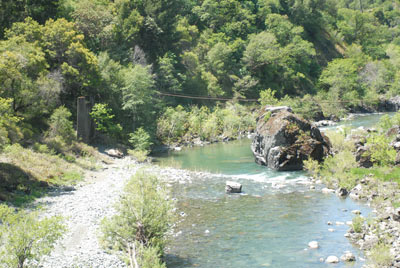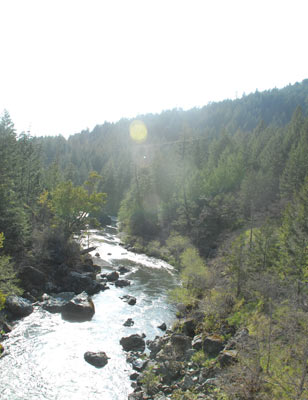Fiction: "The flows in the lower Eel River are too low for salmon to migrate into the river because of the Potter Valley diversion."
On October 2, 2010 an article was published in the Eureka Times-Standard titled "Desperately seeking salmon to count: Divers aim to get a picture of how Eel River diversion affects fish". The article, written by John Driscoll, contends that the Eel River is so low that salmon and steelhead can't migrate up stream and that this condition is due to the Potter Valley Project diversion. The article says that "Divers scoured holes on the lower Eel River on Friday looking to get an estimate of how many salmon and steelhead have moved in from the ocean so far". The article goes on to state "Higgins has been contracted by the Friends of the Eel River to get an idea about how the first salmon and steelhead are affected by the diversion to the Russian River. Currently, some 130 cubic feet per second of water is being sent through the diversion tunnel to Potter Valley into Lake Mendocino. Only 28 cfs is being released into the Eel."
The article states that, on the day in question, there were 120 cfs going through the Potter Valley Project powerhouse and only 28 cfs were being released below Van Arsdale on the Eel River. We are not sure what day these numbers represent because our review of the nightly reports from Pacific Gas and Electric do not show these exact values, however the main points are, as usual, left out of stories told by the Friends of the Eel River and their partners.
 Take today, for example, October 6, 2010. The flows through the Potter Valley Project are 91cfs and the flows below Van Arsdale on the Eel River are 34 cfs. What this tells you is only a very small part of the entire story of the river. The releases from Lake Pillsbury today are 122 cfs, 91 cfs are being diverted through the Potter Valley Project, that leaves 31 cfs. If 34 cfs are being released below Van Arsdale that means that the accretion flows between the dams is about 3 cfs. Those are the natural flows from the tributaries that come into the Mainstem of the Eel River between Scott Dam and Van Arsdale. The minimum flow required by NMFS below Van Arsdale on the Eel River today is 19 cfs. This number is based on models of accretion flows and whatever flow is coming into Lake Pillsbury. Therefore, PG&E is exceeding the minimum required flow by 15 cfs. PG&E is releasing nearly double the natural flow in this branch of the Eel River. What about the rest of the Eel River?
Take today, for example, October 6, 2010. The flows through the Potter Valley Project are 91cfs and the flows below Van Arsdale on the Eel River are 34 cfs. What this tells you is only a very small part of the entire story of the river. The releases from Lake Pillsbury today are 122 cfs, 91 cfs are being diverted through the Potter Valley Project, that leaves 31 cfs. If 34 cfs are being released below Van Arsdale that means that the accretion flows between the dams is about 3 cfs. Those are the natural flows from the tributaries that come into the Mainstem of the Eel River between Scott Dam and Van Arsdale. The minimum flow required by NMFS below Van Arsdale on the Eel River today is 19 cfs. This number is based on models of accretion flows and whatever flow is coming into Lake Pillsbury. Therefore, PG&E is exceeding the minimum required flow by 15 cfs. PG&E is releasing nearly double the natural flow in this branch of the Eel River. What about the rest of the Eel River?
What are the flows today, October 6, 2010 on the other stems of the Eel River? Have the Van Duzen and the Middle Fork and the North Fork and the South Fork stopped flowing? The USGS gage on the Middle Fork of the Eel River, above the confluence with the Mainstem, shows that there are 14 cfs flowing on October 6, 2010. Below this gage is another USGS gage at Fort Seward. This gage is located 99 river miles below Lake Pillsbury. Today it reads 46 cfs. This includes the Middle Fork, North Fork and the Mainstem flows. Obviously there is some evaporative loss and subsurface flow that occurs in 99 miles of river at the end of a dry summer. The South Fork Eel River USGS gage shows that there are 43 cfs flowing in the river near Miranda. Now, depending on where the divers really are in the "lower river", they are swimming in the accumulated flows from the Middle, North, South and Main branches of the Eel River. The article by Driscoll does not mention what the flows are where the divers are "scouring the river".
 Let's look at the contention of the article by John Driscoll that the low Potter Valley Project flows are to blame for the lack of salmon and steelhead in the Eel River today. It is the beginning of October, there has been no significant rain in the entire watershed since June. All of the tributaries of the Eel River have very little flow; it is the end of summer, and this is natural.
Let's look at the contention of the article by John Driscoll that the low Potter Valley Project flows are to blame for the lack of salmon and steelhead in the Eel River today. It is the beginning of October, there has been no significant rain in the entire watershed since June. All of the tributaries of the Eel River have very little flow; it is the end of summer, and this is natural.
Chinook salmon will stay in the ocean, or very near the ocean in the estuary, until it rains and the river flow increases enough to provide passage flows, cool temperatures and sufficient dissolved oxygen for them to survive. These are some of the environmental "cues" that salmonids respond to as they move into, or out of, river systems. The salmon are obviously smarter than the divers who are looking for them!
As for the Potter Valley Project, the flows below Van Arsdale are too low to make a difference in the overall condition of the river, but today they are higher than some of the other major tributaries of the Eel River. If Scott Dam was gone the contribution today, from the water shed above Van Arsdale, would be, at the most, 19 cfs. In actual fact, the surface flows would probably be nearly exhausted as they would be, at such extremely low flows, below the gravel surface of the river bed.
Let's look at the other side of the story. Let's say we released an unnatural block water flow from Lake Pillsbury today. How would the salmon respond to this flow and what would happen to them? We don't really know how much of a difference a pulse of water would make 126 miles downriver from Scott Dam (it would depend upon the amount and duration of the flow), but if the salmon responded to this type of unnatural pulse of water and began to migrate up the Eel River, and if it didn't rain very quickly, the salmon would be stranded in a dry river. They would be unable to access their natal tributaries. This has happened in the past. In 1980s the CDFG prematurely released a block of water from Lake Pillsbury, cued the fish upriver to the Mainstem Eel, and it didn't rain. The stranded fish spawned in the Mainstem and when the rains finally came, and the huge natural flows arrived, the spawning beds, or redds, which normally would have been dug in safe locations, were washed away and the eggs were lost.
The Friends of the Eel River, once again and with help from Mr. Driscoll, have fabricated a frightening, but entirely false, story of what the Potter Valley Project has done to the Eel River. Salmon have evolved to survive in concert with the changing cycles of the ocean and their rivers. It is an elegant life cycle that we need to protect. And that is why, after over thirty years of studies, the flows released at the Potter Valley Project have been designed to mimic the natural flows of the Eel River at Van Arsdale. All of the other tributaries of the Eel River are unaffected by the Potter Valley Project. To compare the flows of the Eel River tributaries, refer to the USGS gage data posted every day at USGS Real Time Stream Data.
 Take today, for example, October 6, 2010. The flows through the Potter Valley Project are 91cfs and the flows below Van Arsdale on the Eel River are 34 cfs. What this tells you is only a very small part of the entire story of the river. The releases from Lake Pillsbury today are 122 cfs, 91 cfs are being diverted through the Potter Valley Project, that leaves 31 cfs. If 34 cfs are being released below Van Arsdale that means that the accretion flows between the dams is about 3 cfs. Those are the natural flows from the tributaries that come into the Mainstem of the Eel River between Scott Dam and Van Arsdale. The minimum flow required by NMFS below Van Arsdale on the Eel River today is 19 cfs. This number is based on models of accretion flows and whatever flow is coming into Lake Pillsbury. Therefore, PG&E is exceeding the minimum required flow by 15 cfs. PG&E is releasing nearly double the natural flow in this branch of the Eel River. What about the rest of the Eel River?
Take today, for example, October 6, 2010. The flows through the Potter Valley Project are 91cfs and the flows below Van Arsdale on the Eel River are 34 cfs. What this tells you is only a very small part of the entire story of the river. The releases from Lake Pillsbury today are 122 cfs, 91 cfs are being diverted through the Potter Valley Project, that leaves 31 cfs. If 34 cfs are being released below Van Arsdale that means that the accretion flows between the dams is about 3 cfs. Those are the natural flows from the tributaries that come into the Mainstem of the Eel River between Scott Dam and Van Arsdale. The minimum flow required by NMFS below Van Arsdale on the Eel River today is 19 cfs. This number is based on models of accretion flows and whatever flow is coming into Lake Pillsbury. Therefore, PG&E is exceeding the minimum required flow by 15 cfs. PG&E is releasing nearly double the natural flow in this branch of the Eel River. What about the rest of the Eel River?
 Let's look at the contention of the article by John Driscoll that the low Potter Valley Project flows are to blame for the lack of salmon and steelhead in the Eel River today. It is the beginning of October, there has been no significant rain in the entire watershed since June. All of the tributaries of the Eel River have very little flow; it is the end of summer, and this is natural.
Let's look at the contention of the article by John Driscoll that the low Potter Valley Project flows are to blame for the lack of salmon and steelhead in the Eel River today. It is the beginning of October, there has been no significant rain in the entire watershed since June. All of the tributaries of the Eel River have very little flow; it is the end of summer, and this is natural.